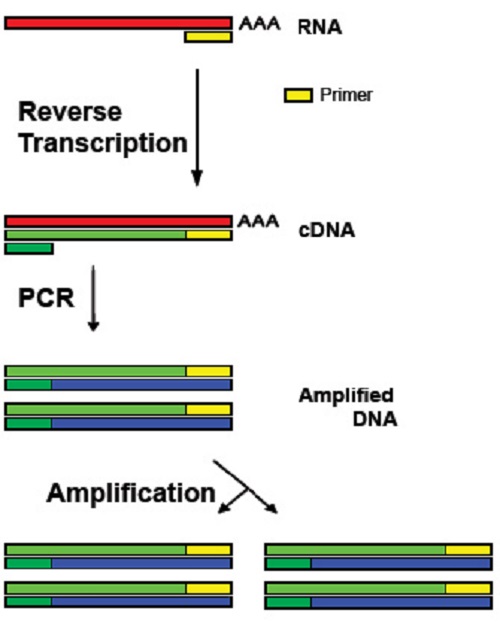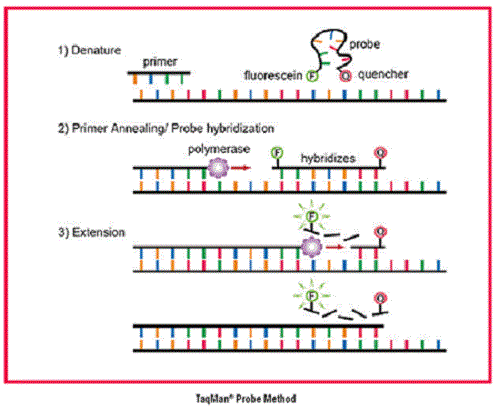Difference Between RT-PCR and QPCR

Reverse transcription polymerase chain reaction (RT-PCR)
RT-PCR vs. QPCR
Advancements in biotechnology have resulted in the discovery of several ways to cope with the demands for organ transplants over the years. Before, an individual who would voluntarily donate any organ immediately after death to a patient in need could only jump-start the operation for transplants. Biologists’ continuous studies and research lead to the discovery of stem cells.
Stem cells refer to those that are taken from the DNA of an embryo, which will serve as the source for the regeneration of cells that would basically be a clone of the organ where the DNA has been retrieved. While human rights activists lobby for the halting of such procedures, successful operations have indeed proven the effectiveness of stem cell developments in organ transplants.
Before one can appreciate and fully understand stem cells, however, there is a need to be familiarized with the different terminologies associated with this scientific discovery. Stem cell cultivation deals with DNA and its coding. Thus, it is vital for students or any individuals interested in the field to differentiate between RT-PCR and qPCR.
Reverse transcription polymerase chain reaction (RT-PCR) is one of the many variants of the polymerase chain reaction, or PCR. This laboratory technique is widely used in molecular biology in order for the scientists to produce multiple copies of a particular DNA sequence through a process coined as “amplification.” The difference between RT-PCR and traditional PCR is that RNA is first transcribed in reverse into its DNA complement, which utilizes the reverse transcriptase. The new complementary DNA containing the reversed transcription will then be amplified using the traditional PCR or real-time PCR.
Most students studying this process often make the mistake of interchanging reverse transcription PCR and real-time PCR as the two are abbreviated similarly. To avoid confusion, biologists label the real-time PCR as quantitative real-time PCR or qPCR.
QPCR differs greatly from RT-PCR, as qPCR is responsible for measuring amplification as it occurs. It can be said that RT-PCR starts the amplification process, while qPCR measures it as the procedure takes place.

Quantitative Real-Time PCR
QPCR has actually revolutionized the traditional one-way approach method when it comes to quantifying DNA and RNA, as applying the qPCR method makes it possible for biologists to determine the initial concentration of the nuclei acid even before the results of the reaction have been observed and jotted down.
The application of qPCR, which is now considered the most powerful and sensitive analysis technique for genetic studies, has widened significantly. It is currently involved in quantitative gene expression analysis, genotyping, pathogen detection, and analysis of SNP, along with RNA interference measurements.
QPCR is often combined with the process of reverse transcription to quantify the messenger RNA and MicroRNA present in the cells of tissues observed and experimented with. This then gives another visible difference between the two: RT-PCR can be used for the amplification process, but it needs to be fused with qPCR for quantification purposes.
QPCR is also known to be more quantitative as the data can be collected as the exponential growth (log) phase of the PCR progresses. Biologists note that the quantity of the byproduct of PCR is directly proportional to the amount of template nucleic acid that will be measured through qPCR.
On the other hand, RT-PCR is far from having a quantitative nature as the observance of the intensity of the amplified band on a gel following the set standard of a concentration may lead to having “semi-quantitative” inference.
Summary:
1.QPCR and RT-PCR are both terms used in biotechnology and utilized for the production of multiple copies of DNA.
2.RT-PCR is used to amplify the reversed transcription of the DNA code; QPCR measures the amplification.
3.RT-PCR is for amplification, while qPCR is for quantification.
4.QPCR is quantitative in nature, while RT-PCR is not.
- Differences Between Fraternity And Sorority - January 8, 2014
- Differences Between Lucite and Plastic - January 7, 2014
- Differences Between Oil and Butter - January 6, 2014
Search DifferenceBetween.net :
1 Comment
Leave a Response
References :
[0]https://en.wikipedia.org/wiki/File:Reverse_transcription_polymerase_chain_reaction.jpg
[1]https://udapbio.wikispaces.com/Aleks?responseToken=07f0365890bf444c0e5265b358e3cfa36

I found the site quite educative and more technical and easy to assimilate information is welcome for modern molecular Biology detection of human diseases.